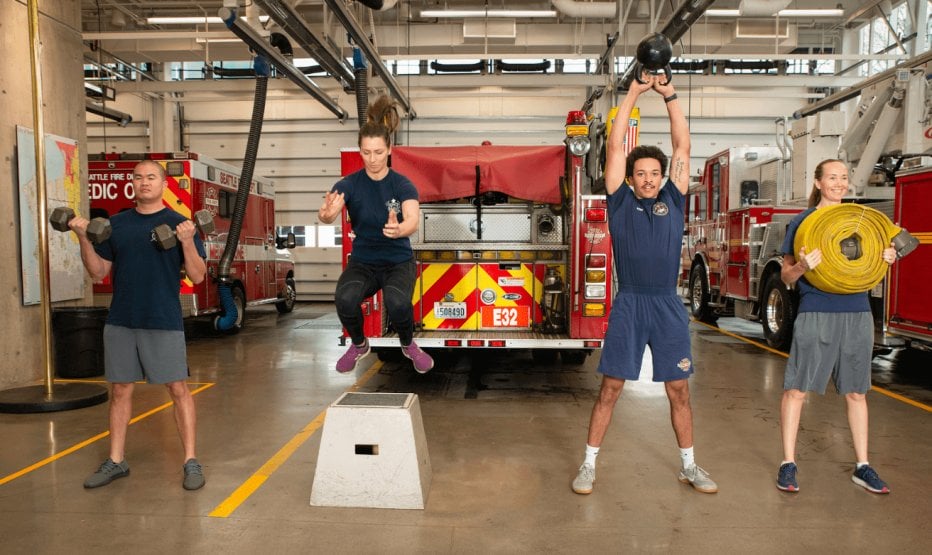Preparing for the Physical Ability Test

By: Kelton Brewer and Hussien Jabai, MS,CSCS,TSAC-F,CPT
Preparing for an entrance or annual physical ability test is no easy task. It takes time, dedication, and a desire to succeed. The majority of all physical ability tests (also known as a JTA – job task analysis for some) are short in duration and can include variations of high-intensity movements. Just like our job as firefighters, short and high intense movements for a short period of time. The job of a firefighter is demanding, and we should be ready at a moment’s notice. Furthermore, firefighters don’t come straight out of the academy being the most proficient at the job, as it takes years of training to improve job performance. Physical fitness is no different, you don’t become physically fit overnight. It takes time and dedication to become better. With that in mind, training our skills as firefighters along with our physical fitness go hand in hand. Hopefully, this article can provide some advice on how you can better prepare for your department’s upcoming physical ability test.
Training for success
Just like training to perfect our craft, physical fitness should be prioritized in the same light. Traditional strength and conditioning principles are crucial to our job preparedness, but the very nature of the occupation requires unique adjustments to any program approach. Being able to maintain a level of strength, power, stamina, and endurance is key to our job. At the end of the day, it’s about balance, incorporating variety into your strength and conditioning program. Maybe you do not know where to begin with creating a workout program, what equipment to use, or how to select movements. Rest assured; it doesn’t take a lot of equipment to create a great high-intensity training session. With respect to high-intensity training, simplicity is key. A great start is using your department’s physical ability test or JTA as a template. If you are a new hire candidate, utilize the physical ability test from the department for which you will be testing. Being able to use certain movements incorporated in JTAs will not only help you increase components of physical fitness but will allow you to focus on your overall job-specific performance skills as well. It also helps bring peace of mind knowing you trained these movements, become more comfortable with performing them, and have confidence in yourself executing them on the day of the event. Here are some examples of movements you can incorporate in a high-intensity training session:
Task #1 Stair climb
(Best replicates musculature used for stair climb tasks)
- Can be performed with a weight vest; bunker gear or no bunker gear.
- Grab a 50ft section of hose, a sandbag, or some type of weighted object you can carry on your shoulder.
- Select the appropriate number of flights of stairs based on your own individual fitness level.
- Alternate the shoulder that the equipment/object rests on evenly throughout the training session.
Task #2 Sled drag/push
(Best replicates musculature used for stair climb or dummy drag tasks)
- Utilize a sled if you have access to. Some sleds may have a rope, harness, post, or handle attachment
- If not, rig a section of hose to either a tire (various size/type) or coupled together with other sections for added resistance. You could get fancy and use a defective hose to fill with sand… be creative.
- Alternate the forms in which you drag the sled, hose, or tire. (alternating between forwards, backward, and even laterally)
Task #3 Farmers carry
(Best replicates musculature used for equipment carry or load carriage tasks)
- You can use almost any object for these. Dumbbells, kettlebells, foam buckets, rolls of hose.
- Alternate between methods of holding a weight in each hand and performing bouts where you hold weight solely in one hand. This variation in weight distribution will encourage using the musculature of the core to maintain proper posture during the carry.
Task #4 Kneeling pulls
(Best replicates musculature used for kneeling hose pull)
- While kneeling with a sled, fire hose, fire hose with a tire, or battle rope with an object on the end of it.
- Pull the object to yourself. This requires alternating rowing or pulling movements with each arm, alternating arms with each pull.
- With each round, alternate the knee that is being placed on the ground.
These are just a few of the many movements you can incorporate into your strength training. Finding the balance in programming both “traditional” exercise selections and nontraditional physical ability tasks is not easy. Having an upcoming physical ability test to prepare for makes incorporating these various movements at a high intensity more desirable and easier to plan for. As previously mentioned, training is key, for both our skills and physical fitness. Maybe you are preparing as a new hire candidate or your upcoming annual. Whichever one it is, here are some tips you may find helpful.
Prior to the Physical Ability Test
Tip #1 Preparation starts at home
It is vital to focus on high-quality sleep prior to the event. Consider other key factors such as proper hydration and nutrition. These should be reflected on, and a plan of action should take place days if not weeks in advance of the event.
Tip #2 Know the test
Examine the physical ability test task list and see what you will be tested on. Also observe the format of testing, duration, limitations, equipment, and environment.
Tip #3 Practice the tasks
Replicate the tasks that are in the physical ability test. Become familiar with your strength and weaknesses. Learn your unique approach to strategic “tactical breathing” and where/how you will pace yourself in certain areas. Discover your weaknesses and address them with the next tip.
Tip #4 Incorporate physical fitness training
Once you’ve established your weakness, incorporate those movements into your training. Also, train with exercises that target the same muscle groups, movements, tempo, and durations which will best replicate the tasks of the event. Use these new exercises to fuel the improvements of areas in which you lack. Most physical ability test tasks are short, quick, and incorporate high-intensity movement discussed prior in the article. Base your training around those movements, or exercises that target components of those tasks.
Tip #5 Nothing fancy required
Use the equipment you have at the station or at home. You don’t need fancy equipment for a good workout. If you need assistance in strategically designing workouts that best fit the limited equipment that you have access to, reach out to qualified strength and conditioning professionals. There are plenty of variations that can be implemented for traditional.
Tip #6 Rotate, hip, unilateral
These three concepts should be HUGE in your training program. Rotational movements should be included in every program, to assist with your ability to maintain healthy movement and rotational efforts. Incorporate hinge-oriented movements to create a solid foundation for both “picking up” or “carrying” based tasks, as well as for structural integrity for many strength-based tasks. For unilateral, think of this as single limb (single arm or single leg) based movements. Many of your tasks, as tactical personnel, require the use of one arm or one leg at a time for tasks (such as hose pull, hose hoist, ladder raise, and stair climb). It makes no sense to ONLY base all of your training around very bilateral or double limb tasks (such as back squat, traditional deadlift, bench press, etc) if your performance is primarily unilateral. That does not mean there is no place for them. This just means you should consider some focus on unilateral movements.
Tip #7 Consider the preparation timeline
Give yourself enough time to build up the work capacity and overall endurance for the testing date. Understand where your baseline fitness level is, where you need to reach it, and realistically the timeline to acquire that fitness or performance level appropriately. Don’t wait till the last few weeks and blast your muscles, joints, ligaments, and bones with way more than you can recover from. Your training program should follow principles of progressive overload, gradually increasing “stress” or “strain” over time. In light, this means gradually doing more than you are used to. Preparing for any physical ability test takes consistency and discipline.
Tip #8 Mobilize often
Make flexibility and mobility training a priority. Implement mobility routines into your daily schedule, as these could assist with both performance and quality of life. Increased performance, higher quality movement, and higher quality of life could contribute to the quality of years on the job and less time off due to preventable injuries.
The Day of the Physical Ability Test (or JTA)
Tip #1 Fuel the body
Ensure you have been hydrating properly. This occurs not just the night before but many days in advance. Also, acquire quality sleep prior to the event. You should already have a set sleep hygiene routine that has become a habit prior to the week of the event.
Tip #2 Prep the body to perform
Warm up before the event. Perform dynamic movements and stretches before your turn to help prepare the body for high-intensity tasks and movements.
Tip #3 Observe and analyze
Watch other members or candidates while they perform the physical ability test. You might learn something or be able to perform the movements more efficiently.
Tip #4 Speak up, ask questions
Ask questions to your proctor if you have any confusion about the movements. It is never a bad thing to ask. Asking questions may assist in removing any doubts you may have due to uncertainty and help reduce the possibility of penalties.
Tip #5 One task at a time
Adrenaline, nerves, and excitement will be running high. Remember to breathe and focus on one task at a time.
Tip #5 Perform efficiently, pace effectively
Take your time with each task. Don’t spend all your energy in the first few tasks, draining all your energy by trying to blast through the first task or two with everything you have. Spread your energy out and pace yourself throughout the entire physical ability test. Based on the effectiveness of your training program, you should already have an idea of your pacing method, breathing technique, energy conservation strategy, and overall performance.
Tip #6 Recover
After completing the testing event, make sure to rehydrate and perform a cool-down activity.
Photo by: Stephen Baer
Podcast
Contests & Promotions
















